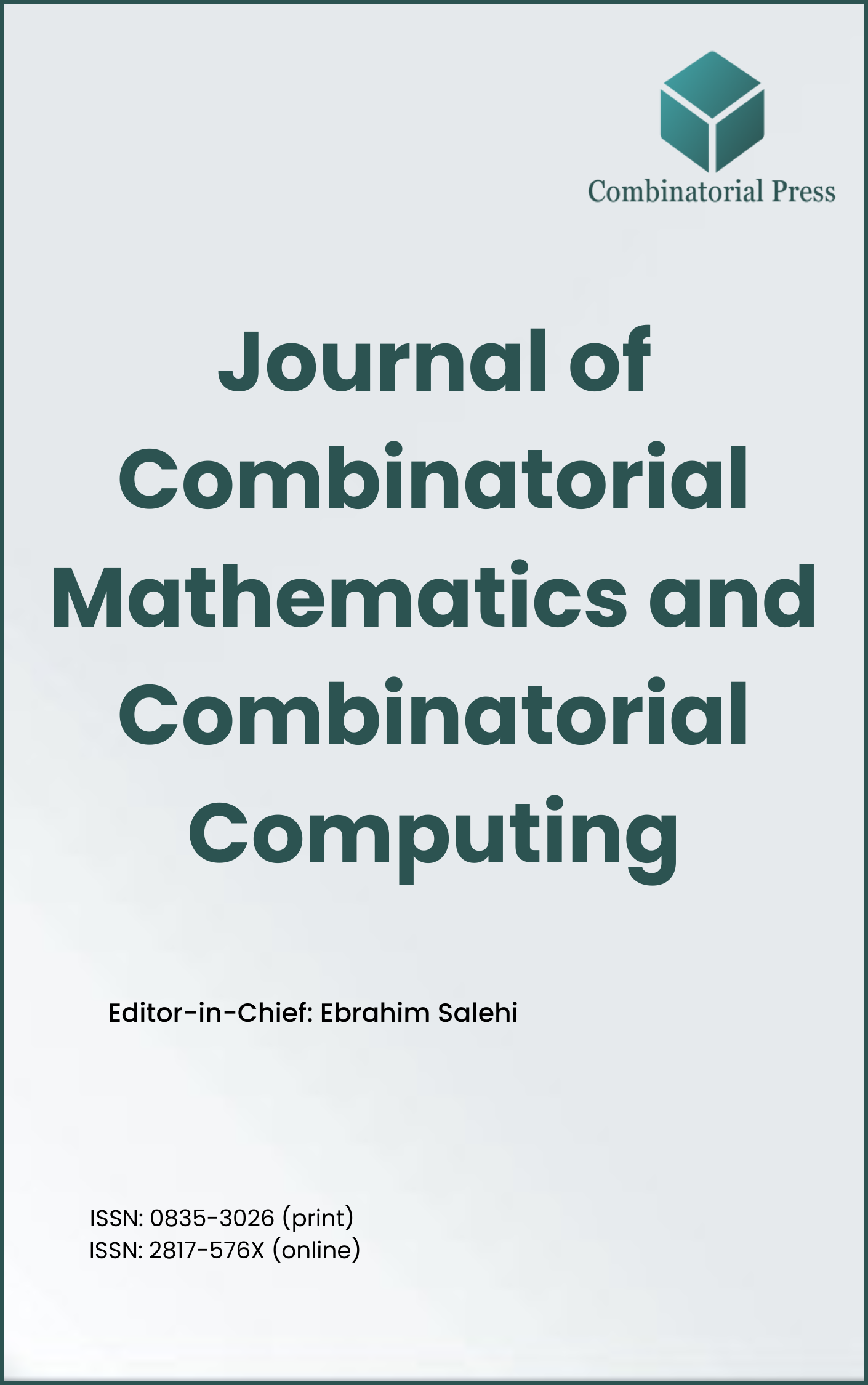
Journal of Combinatorial Mathematics and Combinatorial Computing
ISSN: 0835-3026 (print) 2817-576X (online)
The Journal of Combinatorial Mathematics and Combinatorial Computing (JCMCC) embarked on its publishing journey in April 1987. From 2024 onward, it publishes four volumes per year in March, June, September and December. JCMCC has gained recognition and visibility in the academic community and is indexed in renowned databases such as MathSciNet, Zentralblatt, Engineering Village and Scopus. The scope of the journal includes; Combinatorial Mathematics, Combinatorial Computing, Artificial Intelligence and applications of Artificial Intelligence in various files.
Information Menu
- Research article
- Full Text
- Journal of Combinatorial Mathematics and Combinatorial Computing
- Volume 001
- Pages: 141-148
- Published: 30/04/1987
- Research article
- Full Text
- Journal of Combinatorial Mathematics and Combinatorial Computing
- Volume 001
- Pages: 131-140
- Published: 30/04/1987
The polynomial algorithms for isomorphism testing in \(3\)-regular graphs known to date use set-wise stabilisation in \(2\)-groups acting on singletons, pairs, and sometimes triples of vertices. In this note we describe a new, simpler way of “getting rid of the triples”. Although the order of the complexity of isomorphism testing remains \(O(\text{n}^3 \log \text{n})\), the resulting algorithm is more efficient, since this portion of the set-wise stabilisation in the algorithm will be faster.
- Research article
- Full Text
- Journal of Combinatorial Mathematics and Combinatorial Computing
- Volume 001
- Pages: 125-130
- Published: 30/04/1987
In thie paper, various constructions for resolvable group divisible designs with block size \(4\) are given.
- Research article
- Full Text
- Journal of Combinatorial Mathematics and Combinatorial Computing
- Volume 001
- Pages: 115-124
- Published: 30/04/1987
A group satisfies PP3 (the permutation property of degree \(3\)) if any product of \(3\) elements remains invariant under some nontrivial permutation of its factors, or equivalently, if \(G\) has at most one nontrivial commutator of order \(2\). A PP3 group is \(\underline{\text{elementary}}\) if it is a finite group of exponent at most \(4\). There is an algorithm that associates an elementary PP3 group to an arbitrary graph. It follows, for instance, that almost every nontrivial graph automorphism has order a power of \(2\) and that the first-order theory of (elementary) PP3 groups is hereditarily undecidable.
- Research article
- Full Text
- Journal of Combinatorial Mathematics and Combinatorial Computing
- Volume 001
- Pages: 107-114
- Published: 30/04/1987
A generalization of Sperner’s labeling for simplices is considered. It allows us to give any label not only to points from the interior of the simplex but also to points from the relative interior of each facet, while the Sperner labeling rule is preserved for all points on the boundary of each facet. Some properties of this labeling and its behavior on the facets of the simplex are discussed. Also, necessary and sufficient conditions for the existence of an odd number of completely labelled simplices in any triangulation of the simplex are given.
- Research article
- Full Text
- Journal of Combinatorial Mathematics and Combinatorial Computing
- Volume 001
- Pages: 97-105
- Published: 30/04/1987
Orthomorphism graphs of groups are defined and a correspondence, between cliques of orthomorphism graphs and difference matrices and generalized Hadamard matrices, is established. Some examples of orthomorphism graphs are given.
Also, for \(\lambda = 1\), known values and bounds for clique numbers of orthomorphism graphs of groups of small order are surveyed.
- Research article
- Full Text
- Journal of Combinatorial Mathematics and Combinatorial Computing
- Volume 001
- Pages: 85-96
- Published: 30/04/1987
In this paper we consider the problem of characterizing directed graphs of specified diameter. We are especially interested in the minimal number of arcs \(\textbf{a(d,n)}\) required to construct a directed graph on \(n\) vertices with diameter \(d\). Classes of graphs considered include general digraphs, digraphs without cycles of length \(2\), and digraphs with regular indegree or regular outdegree. Upper bounds are developed in cases where the exact solutions are not known.
- Research article
- Full Text
- Journal of Combinatorial Mathematics and Combinatorial Computing
- Volume 001
- Pages: 67-84
- Published: 30/04/1987
- Research article
- Full Text
- Journal of Combinatorial Mathematics and Combinatorial Computing
- Volume 001
- Pages: 23-66
- Published: 30/04/1987
- Research article
- Full Text
- Journal of Combinatorial Mathematics and Combinatorial Computing
- Volume 001
- Pages: 13-22
- Published: 30/04/1987
In assessing the “vulnerability” of a graph one determines the extent to which the graph retains certain properties after the removal of a number of vertices and/or edges. Four measures of vulnerability to vertex removal are compared for classes of graphs with edge densities ranging from that of trees to that of the complete graph.




